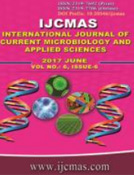


 National Academy of Agricultural Sciences (NAAS)
National Academy of Agricultural Sciences (NAAS)

|
PRINT ISSN : 2319-7692
Online ISSN : 2319-7706 Issues : 12 per year Publisher : Excellent Publishers Email : editorijcmas@gmail.com / submit@ijcmas.com Editor-in-chief: Dr.M.Prakash Index Copernicus ICV 2018: 95.39 NAAS RATING 2020: 5.38 |
Thirteen different varieties of pearl millet locally grown in Haryana were analyzed for antinutrient content (polyphenol and phytic acid) and mineral content. Significant variation was noticed among different varieties i.e., 403.7 to 521 mg polyphenol/100 g and 577.7 to 620.7 mgphytic acid/100 g. Polyphenol and phytic acid was found maximum in HHB-146 and HHB-67 and minimum content observed in WHC-901-445 and HHB-226, respectively varieties of pearl millet. Pearl millet varieties were also contained appreciable amount of mineral content i.e., potassium, magnesium, calcium, iron, zinc and copper varied from 171.6 to 215.3, 64.1 to 72.0, 27.2 to 37.3, 2.7 to 6.4, 1.3 to 1.9 and 0.1 to 0.5 mg/100 g, respectively. Different treatments such as soaking, fermentation, blanching and roasting can enhance the bio-availability of these minerals by decreasing the level of antinutrients. Therefore, knowledge of nutrient content of these locally grown pearl millet varieties may help in the commercial processing of these grains into value-added food and beverage products which can be an important driver for economy and to curb malnutrition in developing countries.
 |
 |
 |
 |
 |